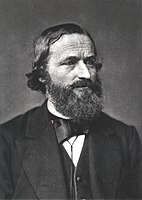
Photo from wikipedia
The photophysical properties of two series of phosphorescent rhenium(I) complexes, [Re(CO)2(N^N)(tpp)2]+ and [Re(CO)3(N^N)(tpp)]+ with carbon monoxide (CO), triphenylphosphine (tpp) and α-diimine (N^N) ligands have been investigated in deoxygenated acetonitrile solution… Click to show full abstract
The photophysical properties of two series of phosphorescent rhenium(I) complexes, [Re(CO)2(N^N)(tpp)2]+ and [Re(CO)3(N^N)(tpp)]+ with carbon monoxide (CO), triphenylphosphine (tpp) and α-diimine (N^N) ligands have been investigated in deoxygenated acetonitrile solution at room temperature and in solid methanol/ethanol 1 : 1 matrices at 77 K. The complexes display moderate to strong phosphorescence which is related to the N^N ligand modulated metal-to-ligand charge-transfer S0 ← 3*MLCT or intraligand S0 ← 3*LC transitions. Luminescence properties of the investigated series have been found to be very similar but some intrinsic differences between them are clearly seen. Whereas the [Re(CO)2(N^N)(tpp)2]+ series shows MLCT emission in both temperature regimes studied, the [Re(CO)3(N^N)(tpp)]+ series exhibits intrinsic changes in its emission character when the measurement temperature is lowered from 298 to 77 K. In both investigated series, their emission characteristics are strongly affected by the nature of coordinated α-diimine N^N ligands. The observed trends, changes in the radiative kr and non-radiative knr deactivation rate constants, have been compared with those found for the previously investigated [Re(CO)3(N^N)(Cl)], [Re(CO)3(N^N)(CH3CN)]+, and [Re(CO)2(N^N)(dppv)]+ series (dppv = cis-1,2-bis(diphenylphosphino)-ethene). Similarities and differences in the spectroscopic and photophysical properties of five series of the Re(CO)3+ and Re(CO)2+ complexes have been analyzed in the view of results from DFT and TD-DFT computation and the emission band-shape analyses performed according to the Marcus–Jortner formalism.
Journal Title: RSC Advances
Year Published: 2020
Link to full text (if available)
Share on Social Media: Sign Up to like & get
recommendations!